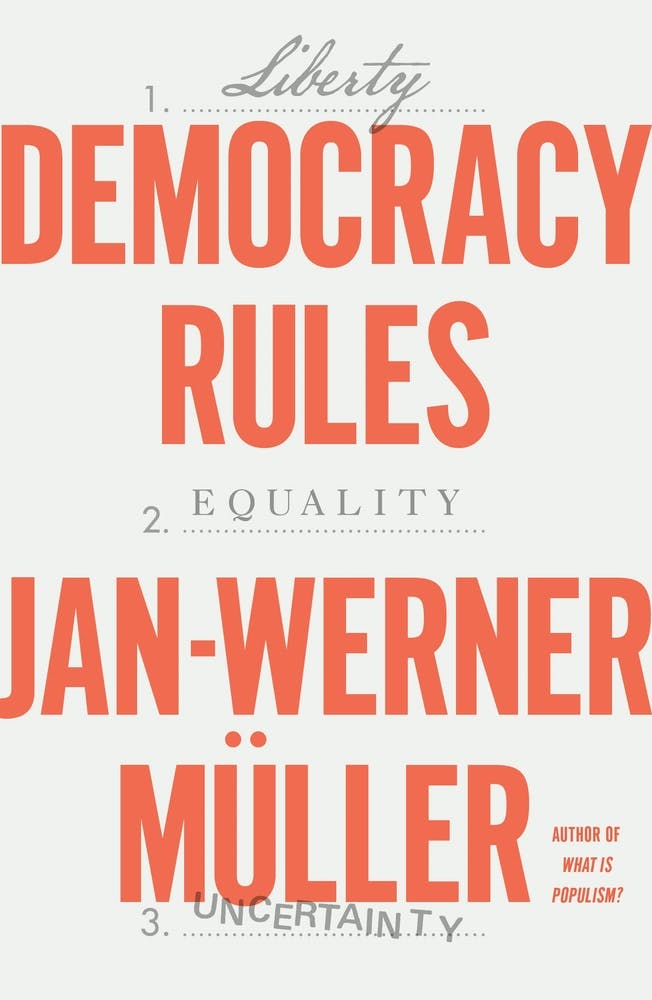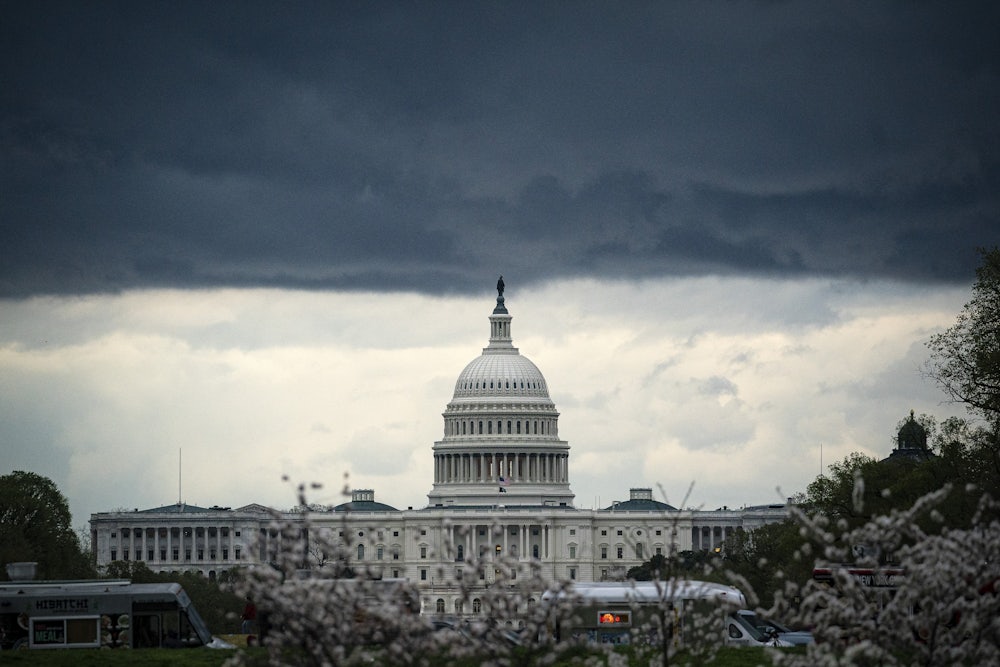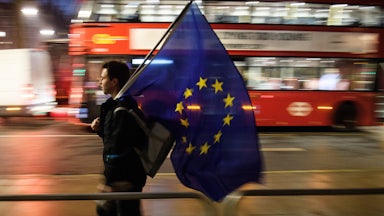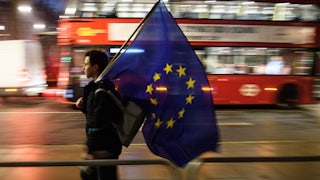For all that ails Western democracy at the moment, it certainly doesn’t lack diagnoses. Critics such as Jonathan Rauch insist that a surfeit of popular sovereignty has tipped the delicate balance of self-governance in the direction of strongman ethnic nationalism. Norman Ornstein and Thomas E. Mann call out the structural woes that afflict America’s two-party system when one of the major parties embraces a nihilist anti-politics of procedural obstruction and minoritarian system-rigging. And scores of political scientists have decried an anti-institutional, elite-baiting brand of populism as the corrosive force that, seemingly overnight, has transformed representative democracy into a great rolling system of score-settling authoritarian grievance.

German political scientist Jan-Werner Müller brings together a range of these diagnoses in Democracy Rules, an accessible and engaging examination of “authoritarian populism” in our times. For much of his brief survey, Müller contrasts the power grabs, resentments, and ethnonationalist agendas of today’s far-flung authoritarian movements with the principled demands of democratic self-rule. To secure these demands, he argues, we must return to the basics of political thought, conceptualizing how, and for whom, government should work. “What we are really interested in is not just ‘the people’ in the abstract, but the people as a democratic people,” he writes. This notion “presumes that a distinct group is committed to realizing a way of life according to principles of equality and freedom”—and, further, presumes that this group will use the power of the state to observe and reinforce basic “hard borders” of democratic practice, such as a principled refusal simply to expel or disfranchise citizens.
If this sounds a bit like piling principled commitment upon principled commitment, that’s one of the persistent troubles with Democracy Rules: The truths Müller expounds may well be self-evident, and they are worthy goals for Western democracies presently roiled by crises of legitimacy and longer-term policy drift—but Müller’s analysis rarely engages with the root causes of these crises. He proposes procedural fixes that are well-considered but leaves them largely to float in a conceptual and ideological vacuum. Populism is the villain of this book. But that may be largely because it misconstrues a tradition that could revitalize democracy.
Müller insists that populism is by definition an exclusionary and coercive exercise of ethnic and racial privilege. Populists, Müller writes, “claim that they, and only they, represent what they often refer to as the ‘real people’ or also the ‘silent majority.’” Müller sees this maneuver as the fast track to right-wing repression: Populists’ model “is to divide citizens as much as possible” by claiming that one group is the “real majority” while deeming its rivals interlopers, outsiders, or shadowy elites. These invidious efforts create a bureaucratic and judicial regime premised on what philosopher Kate Manne terms “trickle-down aggression”—a brand of ethnonationalist confrontation sanctioned and carried out by the administrative state when it’s delivered into populist hands.
From there, it’s but a short step to rampant corruption and self-dealing. Claiming to embody the general will of the “real people,” autocrats weaponize state power in their own image: They reward supporters with patronage and threaten their opponents with the “loss of jobs or benefits.” One representative model of this practice, Müller writes, is the autocratic regime of Recep Tayyip Erdoğan in Turkey, which initially tried to delegitimize a series of municipal elections that Erdoğan’s party lost in 2019; when a follow-on ballot delivered still heavier losses to Erdoğan’s side, the Turkish leader simply reduced funding and access to other resources to the mayor in Istanbul and other cities that turned out heavily for Erdoğan’s opposition. A similar consolidation of power at the top has occurred under Viktor Orbán in Hungary, where reform liberals won electoral victories at the local level but were drained of day-to-day operational resources by the top.
Populist division and bureaucratic aggression spread so rapidly through rickety formal democracies, Müller observes, that popular dissent itself becomes hopelessly muddled and misdirected. Citing former Trump consigliere Steve Bannon’s assertion that the self-proclaimed “resistance” from the left was in fact “our friend,” Müller argues that while of course “citizens should not refrain from taking to the streets to protest,” the strongman sowers of populist discord have nonetheless placed the forces of dissent on a precarious footing. The simple top-down logic of authoritarian populist demagogy means that even principled protest can be stigmatized as anarchic discord fomented by this or that group of outside agitators. It’s thanks to this same elite-baiting dynamic, Müller argues, that “the opposition-friendly ‘fake media’ were also the Trumpists’ friends.”
There are of course real hazards in formulating broad-based responses to demagogic, bigoted strongman movements—but the notion that authoritarian populism has so deeply infected public discourse that fighting it with movement-style protest can play into its own sinister and divisive agendas seems a quasi-paranoid flourish not at all out of line with Trumpian and Bannonite rhetoric in its own right. (What’s more, there’s no small hazard in elevating Steve Bannon, a very lucky but otherwise slipshod theorist of far-right reaction, as an authority in these matters—indeed, Müller himself, a few pages on, dismisses the idea that Bannon himself is a very coherent thinker, citing Bannon’s own disclaimer that “I’m just some fuckin’ guy making it up as I go along.”)
Anti-populism also colors a baffling discussion in Democracy Rules of the alleged family resemblance between populism and technocracy. Müller argues that just as “the technocrat holds that there is a single rational solution to any policy problem,” “the populist claims that there is a unique authentic will of the people and that such a will cannot fail to aim at the common good.” The upshot is that “technocracy and populism are both anti-pluralist or even antipolitical.” At this level of abstraction, it’s hard not to conclude that populism has become for political scientists what critical race theory has lately for the culture warriors of the American right: a floating signifier that can accommodate virtually any imputed agenda, so long as all bad-faith interlocutors agree in advance that it’s deeply antithetical to the American experiment.
Müller’s line of argument distorts the actual legacies of populism, particularly of American populism. Thanks in no small part to the anti-populist revisionist scholarship of Richard Hofstadter, generations of theorists and pundits have carelessly branded any and all reactionary and bigoted formations on the right as the spirit of American populism, pure and simple. But the Populist movement of the late nineteenth century was actually an ambitious and unprecedented bid to rid American politics of the divisive forces of racist reaction and to establish a truly democratic cooperative commonwealth, founded on the productive labor of disenfranchised farmers and workers—Black, white, and foreign-born.
As movement populism collapsed in the wake of the 1896 presidential election, Southern Populist political leaders fell into line with the Bourbon-and-Redeemers putsch that institutionalized Jim Crow rule in the region, and curdled in remarkably short order into ugly and bigoted demagogues. But that outcome was anything but preordained, and to glibly assert that the essence of American populism is ethnic exclusion, racist reaction, and cronyist self-dealing is to willfully misread what the movement believed and sought to accomplish at the height of its social-democratic influence.
It’s more than a little wearisome to continue insisting on this point amid the recent barrage of tracts that demonize populism as Democracy Rules does. But it’s crucial to preserve the actual vision of Populist organizing as it took root in this country, since it continues to offer ways to reclaim substantive democratic self-rule. Far from enabling the white nationalist takeover of our democracy, the socioeconomic agenda of Populism could reset our politics on a basis of genuine equality, racial equity, and mass participation. Automatically defaulting to the Hofstadter caricature of Populist politics simply cedes the energies of the movement to the right.
What can get us out of the current crisis? Müller contends that a vital feature of an orderly and functioning democracy is “institutional uncertainty”—that is, a polity’s ability to absorb the sort of mass-political shocks that Western democracies have endured in the Trump and Brexit age without lapsing into anti-democratic subterfuge on the Erdoğan or Orbán model. A robust democracy should ensure reinforcing the peaceful transition of power between parties after elections. It also “protects members of a onetime majority who might want to change their mind,” Müller argues—even when that means they exercise their capacity to “change their minds about democracy, and how it’s realized through particular rules at any given point.”
Tellingly, Müller is better able to document how this dictum has been violated in recent political campaigns than to cite instances when it has been observed. When Mitt Romney said that 47 percent of the electorate leaned Democrat because they were “dependent upon government,” he was writing off their ability to change their minds; as was Hillary Clinton when she characterized the hard-core of Trump’s base as “deplorables” who were “irredeemable.” Müller does suggest, however, that Trump’s abysmal leadership over the course of the Covid-19 pandemic could have provoked some justified reversals of support in the electorate, since the symbolic role a president plays in a major crisis translates into a revised popular estimation of that leader’s competence.
Müller proposes that, to rescue democracy, we need to adopt a set of well-chosen procedural reforms. Many of these are laudable. He explores the deployment of “democracy dollars” as a means of lowering the financial entry barriers to political campaigning—an innovation advocated by Harvard University law professor Lawrence Lessig and adopted on a provisional basis (with so-far equivocal results) in Seattle. He also advocates, following the lead of New York University journalism professor Jay Rosen, the revival of a civic-minded approach to news gathering and broadcasting, soliciting the advance input of citizens in shaping news agendas, and permitting in the process the journalists to act as “partisans of democracy” when “democracy is itself at stake.”
But such programs tend to collapse into question-begging paradoxes in the absence of a clear public mandate behind them: Who decides what brand of citizen input should translate into a journalistic mission? What, not incidentally, becomes of the critical civic mandate of the press to tell the public news that it is in no way predisposed to hear or approve of? And what real-world constituency is going to get democracy dollars—or any other sort of anti-corruption model of electioneering—off the ground in a serious way in a federal system honeycombed with plutocratic interests and agendas in all branches of government, at every level of our politics?
These are at bottom questions of popular—and yes, Populist—mobilization. A truly populist model of politics—that is to say, one that extends the model of expansive democratic political participation to our lives in the broader political economy—includes urgent mandates to accrue, exercise, and delegate actual political power: a central mission curiously absent from both liberal politics writ large and accounts of the need for its procedural reinvention such as Democracy Rules. Rather than encouraging the robust mobilization of citizens into new, more expansive conceptions of the common good, Müller would seem to prefer to engineer the optimal conditions of democratic participation in advance, making slightly upgraded versions of the party system and the press the main business of a democratic polity.
Though Müller concedes that major parties across the West find themselves in a state of drift, he remains optimistic that the system can simply be tweaked into working. “The best response” to the assault on the infrastructures of Western democracies, he writes, “is to regulate in line with basic democratic principles and encourage citizens themselves to take responsibility for this repair by equipping them with the resources to finance both parties and media.” Yet here again we run into questions of power and its distribution: Who, exactly, is doing this regulating and equipping, and what are the incentives behind their program? The public here is being envisioned as clients—funding and grant recipients—of an unspecified body of pro-democracy patrons.
As the Populists of the late nineteenth century would remind us, that’s not really how any of this works. They envisioned a republic founded on the just reward of productive labor—indeed, the central plank of their socioeconomic program was the invention of a new currency system, based on workers’ and farmers’ contributions to the common good. The idea was not to reregulate the corrupt and moneyed party system of Gilded Age America—it was, rather, to galvanize a mass movement of producers to remake the American political economy into a truly equitable network of bottom-up democratic inclusion and participation. This was the vital, direct outcome of an aroused public seeing itself experiment in democratic forms—and it came about via concerted pressure from outside the intermediating institutions of party and press, not within them.
Indeed, it was the embrace of the party system that proved the death knell of the Populist movement. When the Populists ran on a fusion ticket with the Democratic Party in the 1896 election, the grassroots network of Farmers Alliance and labor reformers fell to pieces amid the wreckage of William Jennings Bryan’s failed presidential candidacy. In other words, the Populist insurgency’s move into electoral major party politics entailed the sacrifice of movement lifeblood—and its erstwhile leaders descended into the ugly, bigoted politics of racial and nationalist division that now serves as the byword for populism across the political science academy.
And just as the original Populists helped pioneer movement reform grounded in their own experience of how industrial capitalism was besieging their livelihoods and hollowing out the bulwarks of democratic life, the labor movement today holds the best hope for achieving far-reaching democratic and grass roots in our own rampaging Gilded Age. Like the Populist movement, labor can accrue the power to directly intervene in, and remake, unjust economic arrangements at their roots, rather than awaiting a Goldilocks-style arrangement of surrounding institutions. And like the cooperative commonwealth of the nineteenth century, self-organized workers in today’s desperately precarious political economy can prod a sclerotic political order into new and ambitious registers of social-democratic expansion, from worker ownership plans to Medicare for All.
But in Müller’s institutionalist scheme of analysis, unions and workers are another AWOL constituency in the vast phantom public: While he acknowledges the salience of inequality as a defining issue, organized labor—the chief mass-democratic institution designed to address the issue head-on—doesn’t rate any discussion here. (The closest he comes to any such mention, not surprisingly, is a discussion of the recent fortunes of left-European party formations, such as the British Labour Party, Spain’s Podemos, and France’s La France Insoumise.)
Against the backdrop of today’s crises, an oversight on this scale seems astonishing. At the same time, however, such blind spots are all but inevitable, so long as one of the hard borders around inquiry reads, “No Populists allowed.”








